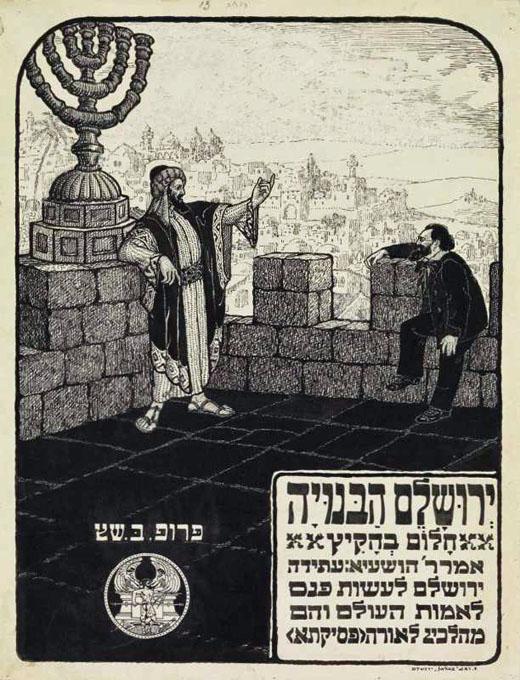Hebrew translation:
Built-up Jerusalem, a daydream
Rabbi Hoshaya said: “Jerusalem will become a lantern for the nations of the world, as they proceed in its light.” (Pesikta)
______________
This image is the cover art for a book entitled Built-Up Jerusalem an iconic text by Boris Shatz, the founder of the Betzalel Academy of Arts and Design
Shatz considered the modern Bezalel museum and artistic workshop to be the equivalent of the ancient temple
The image depicts a trans-historical conversation between ancient and modern Jewish histories with Shatz himself (on the right) in the role of modernity's avatar
The late Nurit Cohen-Shilo wrote an entire book about Bezalel (Hebrew)
Excerpt:
Schatz's "Bezalel": Between a Zionist Icon and Hebrew Art
The Bezalel - Beit Midrash for Arts and Crafts - began operating in February 1906. Since then, it has been considered the representative institution of art in Israel, and not in vain. Zionist leaders saw the need for new Jewish art as part of the national struggle.
They sought an art that would reconnect with the lost aspect of the Jewish person, and make the new Jew a whole person. Art is thus destined for a national role. With its help, it was hoped, it would be possible to internalize Zionism and unite the present and the past and the individual and the group. The establishment of Bezalel was therefore dictated from the outset by ideological and propaganda demands, as well as by constraints arising from the consideration of those tastes that financed the institution directly and indirectly.
In other words, Bezalel was not indifferent to the need to produce art with national roots, guided by ideals that are not detached from the Jewish religion. The vision of Boris Schatz, founder of Bezalel, was thus integrated into the national vision of the funding Zionist leadership. As an integral part of Zionist activity, Bezalel was involved in a desire to create a visual Hebrew environment, the products of which would be sold to the Jews of the world, would constitute a tool of Zionist propaganda. The use of portraits of Jewish personalities, for example, was a means of stimulating the Jewish people and getting to know its heroes and history.

